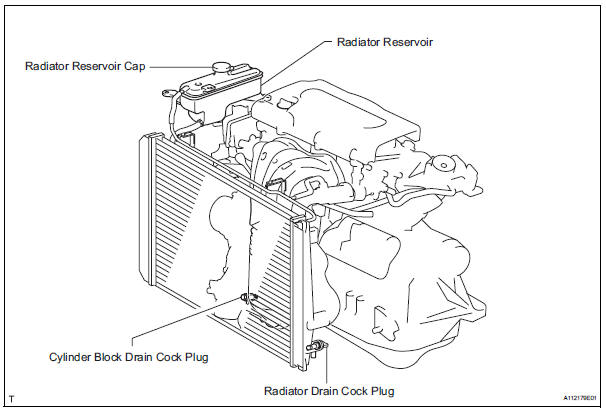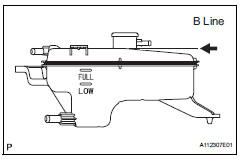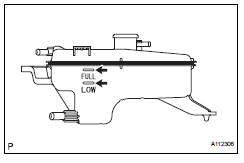Toyota RAV4 (XA40) 2013-2018 Service Manual: Coolant
Replacement
- Remove no. 1 Engine under cover
- Drain engine coolant
- Loosen the radiator drain cock plug.
Hint:
Collect the coolant in a container and dispose of it according to the regulations in your area.
- Remove the radiator reservoir cap.
Caution:
Do not remove the radiator reservoir cap while the engine and radiator are still hot.
Pressurized, hot engine coolant and steam may be released and cause serious burns.
- Loosen the cylinder block drain cock plug.

- Add engine coolant
- Tighten the radiator drain cock plug by hand.
- Tighten the cylinder block drain cock plug.
Torque: 12.7 N*m (130 kgf*cm, 10 ft.*Lbf)
- Add toyota super long life coolant (sllc) to the radiator reservoir filler opening.
- Continue adding toyota sllc until it is filled to the b line at the base of the reservoir's filler neck.
Hint:
The b line is the lower edge of the inner wall of the filler neck.
Standard capacity: 6.8 Liters (7.2 Us qts, 5.9 Imp. Qts)

Hint:
Toyota vehicles are filled with toyota sllc at the factory. In order to avoid damage to the engine cooling system and other technical problems, only use toyota sllc or similar high quality ethylene glycol based non-silicate, non-amine, non-nitrite, non-borate coolant with long-life hybrid organic acid technology (coolant with long-life hybrid organic acid technology consists of a combination of low phosphates and organic acids).
Notice:
Never use water as a substitute for engine coolant.
- Press the no. 1 And no. 2 Radiator hoses several times by hand, and then check the level of the coolant. If the coolant level drops below the b line, add toyota sllc to the b line.
- Install the radiator reservoir cap.
- Start the engine and warm it up until the cooling fan operates.
- Set the air conditioning as follows while
warming up the engine.

- Maintain the engine speed at 2,000 to 2,500 rpm and warm up the engine until the cooling fan operates.
Notice:
- Make sure that the radiator reservoir still has some coolant in it.
- Pay attention to the needle of the water temperature meter. Make sure that the needle does not show an abnormally high temperature.
- If there is not enough coolant, the engine may burn out or overheat.
- Immediately after starting the engine, if the radiator reservoir does not have any coolant, perform the following: 1) stop the engine, 2) wait until the coolant has cooled down, and 3) add coolant until the coolant is filled to the b line.
- Run the engine at 2,000 rpm until the coolant level has stabilized.
- Press the no. 1 And no. 2 Radiator hoses several times by hand to bleed air.
Caution:
When pressing the radiator hoses:
- Wear protective gloves.
- Be careful as the radiator hoses are hot.
- Keep your hands away from the radiator fan.
- Stop the engine and wait until the coolant cools down to ambient temperature.
- Check that the coolant level is between the full
and low line.
If the coolant level is below the low line, repeat all of the procedures above.
If the coolant level is above the full line, drain coolant so that the coolant level is between the full and low line.

- Check for engine coolant leaks
- Install no. 1 Engine under cover
 Cooling fan system
Cooling fan system
Parts location
System diagram
On-vehicle inspection
Hint:
It is normal for the cooling fan to sometimes rotate when the
ignition switch is turned from acc to on.
Check cooling fan ope ...
 Water pump
Water pump
...
Other materials:
Brake pedal
Components
Removal
Disconnect cable from negative battery
terminal
Caution:
Wait at least 90 seconds after disconnecting the
cable from the negative (-) battery terminal to
prevent airbag and seat belt pretensioner activation.
Remove instrument panel sub-assembly
Remov ...
Problem symptoms table
Hint:
Use the table below to help determine the cause of the
problem symptom. The potential causes of the symptoms
are listed in order of probability in the "suspected area"
column of the table. Check each symptom by checking the
suspected areas in the order they are listed. Re ...
Making a call
Once a bluetooth® phone is registered, you can make a call
using the following procedure:
Dialing
Display the phone screen.
Select the “dial pad” tab and enter a phone number.
To delete the input phone number, select
.
For the first digit, you can enter
by selecting &nb ...
